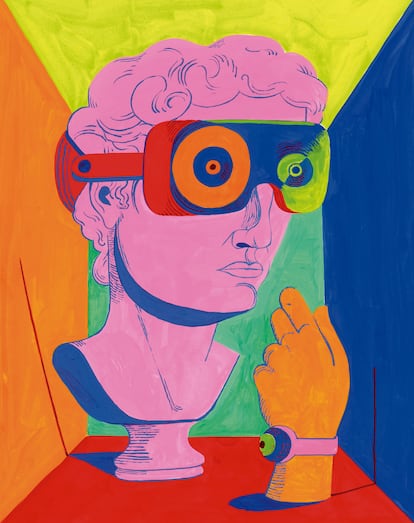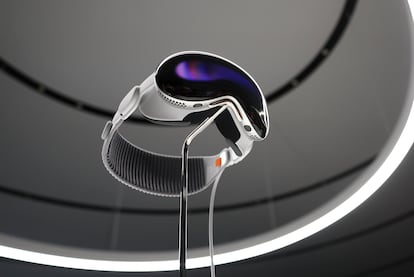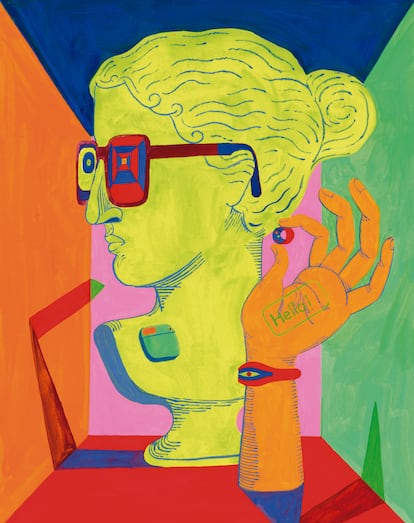Is the mobile phone starting to die?
The smartphone market can no longer grow and AI is promising to revolutionize our habits. Experts say that voice commands and virtual assistants will gain prominence over screens. For the moment, new devices such as glasses, buttons or watches will coexist with the cellphone

An essential personal accessory, a helpful assistant in our daily lives and a status symbol, the mobile phone has been, since the emergence of the iPhone in 2007, a product with a prominence that is difficult to match in other aspects of human life. But perhaps that phase as we know it is over. There are symptoms of fatigue and, along with them, alternatives that suggest an unavoidable decline. Screen addiction is a growing stigma for which the smartphone bears almost all the blame. Almost a third of users are at high risk of suffering from a serious addiction, according to a study published last year in the International Journal of Mental Health and Addiction. The mobile phone has gone from being seen as an object of desire to becoming a harmful device. Digital disconnection is recommended as a synonym of better mental health.
There is also a fact: fewer phones are being sold. “People are still buying smartphones, I’m not saying that suddenly no one uses mobile phones, but the numbers are going down,” stresses Amy Webb, CEO of the Future Today Institute, an advisory firm that helps companies detect technological trends. This consultancy decreed in 2017 that the beginning of the end of the smartphone had begun, as sales had stagnated (we all already have a mobile phone, this market is not going to grow anymore). Although the figures have never returned to the previous days of bonanza, “if we think about the next decade, instead of using just a phone there will be many different devices. And these devices will replace the smartphone. This has already started to happen.” The era of the human who is permanently crouched over a rectangle, the days of faces illuminated by the blue light of a screen, the times of two thumbs moving at the speed of light on a protective plastic are on their way out.

In 2022 there was a sharp drop in units shipped globally: 11.3% less than in the previous year. In the last quarter of the year, when Christmas was supposed to multiply consumption, the decline was even more pronounced, 18.3%. You would have to go back a decade to find such low figures. And the trend persisted last year, with falls of 3.2% or 4%, according to different analysts.
Smartphone manufacturers are looking for other sources of income. The case of Apple is the most representative, because more than half of its turnover depends on iPhone sales, which in the first quarter of 2024 was 10% lower than last year. But the company has made efforts to fish in other waters. It has developed an entire ecosystem of applications that work by subscription, such as Apple Music, News or Fitness. It even produces and distributes its own series through Apple TV to attract users to its universe.
But the mobile phone, understood not only as a device but as a multipurpose knife that has revolutionized the way we communicate, will remain. Several gadgets could be the alternatives to the uses that we have given it. The AI Pin, for example, is a small square electronic medal that hangs on clothing. It receives voice commands: ask it for the weather forecast, if there is a restaurant in the area, or any question you would ask Google. It responds by audio thanks to artificial intelligence. It also projects, if we want, a screen of green phosphorescence on the user’s hand that allows small texts to be read.
Rabbit R1 plays with a similar concept. It is a device halfway between retro and sophisticated that also receives voice queries (and also has a small screen). “The Rabbit R1 does exactly the same thing as an advanced voice assistant,” says Alexander Manu, a professor at the Faculty of Design at OCAD University in Toronto, who has studied technological trends for decades. “I can ask it to book me a flight and a hotel. In fact, by using it I have gone back 25 years, when I called my travel agent to book me a ticket to a destination.”
The list of gadgets that seem born from an Isaac Asimov novel goes on and on. Apple’s latest major launch, for example, are the Vision Pro glasses, which allow users to see their surroundings through the images captured by its high-resolution cameras. They combine this visual perception with the playback of videos and other content. It is as if the user were in a giant, private cinema with a window to the world.
According to their creators, none of these products are intended as an alternative to mobile phones, but it is inevitable to think that they are going in that direction. Devices such as Lucyd smart glasses follow along the same lines, and are the first, according to their creators, to integrate ChatGPT: they understand requests in natural language. But they are not the only ones. Meta launched its own, in collaboration with Ray-Ban, and mobile manufacturers TCL and Oppo have presented their own smart glasses.
This is not the first time that electronic glasses have been tested. Google Glass emerged in 2013 and that name still resonates in the Google offices as a resounding commercial failure. But at that time we were talking about a little toy. Now we are talking about a trend.
For Manu, the abundance of alternatives that dare to challenge the mobile phone is a symptom of the latter’s growing weakness. “People are now very critical of the AI Pin and the Rabbit R1, but if we stop to think about it, people were also very critical of the iPhone when it came out. They made fun of it and said that Apple was going to fail.”
“You have to keep in mind that this is a transition,” says Webb. “We will go from one device to many. If I think back to 1998, I had a laptop, a portable DVD player, my MP3 player and my MiniDisc. And later all these devices became one, which was the smartphone. With artificial intelligence we are going towards a constellation of many devices. I don’t know if the ones that are there now will stay. We will see many others. There will be a lot of experimentation.” Webb’s idea is that each person will have an arsenal of gadgets, and that artificial intelligence will connect them all. It will be this technology that delivers the death blow to the mobile phone as we know it.

In the end, a smartphone is a toolbox. It is full of applications, such as Google, WhatsApp, Gmail, Netflix or Spotify. And we use that box to carry all the tools and use them anywhere. “We have created many applications. And, over time, we have realized that in the end what we want is not the application itself but the benefit it brings us. And artificial intelligence will be what generates those beneficial results that we want,” says Manu. For the professor, this toolbox is now unnecessary. A ChatGPT-type artificial intelligence service will allow you to use the headphones to call or make a query using your voice alone. The role of the smartphone is reduced.
As technology laboratories go, voice communication between people and machines is going to be much more effective than it has been so far with Siri or Alexa. The preferred way to communicate with machines is by talking, just like with people. And what fosters artificial intelligence like the one that exists on the market today is only the beginning. We are getting closer to starting a fluid conversation with an artificial intelligence, in the style of Robert Downey Jr. – that is, Tony Stark – in Iron Man, when he is capable of joking even with Jarvis (his digital assistant). Or Jarvis’ cinematic generational precedent: the supercomputer Hal 9000 from 2001: A Space Odyssey, which had ethical and almost philosophical discussions with its astronaut on duty.
Sonia Villanueva, a consultant specializing in user experience and a professor at the International University of La Rioja, Spain, describes the changes that all this will bring about in our relationship with technology: “We are in a moment of explosion of artificial intelligence. When it evolves, it will materialize into a true personal assistant. And with this, sooner rather than later, we will have a voice relationship, that is, a conversational relationship.” The transformation promises to be an earthquake. “It is much easier to speak than to write,” Villanueva insists.
Such a change will also have an impact on the economy. According to forecasts, artificial intelligence will generate a business of $1.3 trillion in 2030, compared to $150.2 billion last year. It stands to reason that it will be everywhere and on every possible device. Among them, in the so-called wearables: smart watches, bracelets, headphones and even rings. “Nowadays, a cellphone involves seeing, reading and using your hands,” Villanueva adds. “We’ll probably be able to do more things with a voice interface. It’s not that the screen as an interface is going to disappear, but we are going to interact more by voice. This is a revolution,” she says.
The theory of the end of the mobile phone has a powerful enemy: a very visual culture. Instagram, TikTok and YouTube are based on videos and images that are compulsively consumed on a screen. That is one powerful reason for not considering the cellphone dead yet. Even wearable devices require larger screens to view the data they collect. “The reason you need your cellphone is because it’s a bigger window to see information,” Webb admits. “But with some devices, like headphones or glasses, you don’t need a phone. That’s why I think cellphone use will shrink. We are going to be less dependent on it over time.”

Villanueva is also among those who believes that mobile phones will decrease in number but will not disappear. It all depends on what we need to do. “We must distinguish between microtasks, which are activated with simple voice commands, for example: ‘How much does this cost?’ or ‘Open Netflix’, and other uses, such as reading, complex work tasks, viewing a graph or writing an e-mail. This second group of tasks needs visual support,” says this user experience specialist. “That’s why I say that mobile phones are not going to be eliminated in any way. But maybe we will not be glued to the phone all the time for so many things.”
Then again, new technologies could bring another way to introduce the visual element without the need for a mobile phone. Manu throws a question out there: “What would happen if any surface could become a screen? You need this surface to be electronic, of course. But now there are technologies to do it, such as graphene, which is extremely thin and resistant.” Like in Minority Report, where Tom Cruise explored representations of data on glass walls.
There is still a lot of uncertainty ahead. But perhaps the era of the Homo smartphonus that we have become, with our heads down to look at the screens and our fingers flying to write on them, is coming to an end. Perhaps evolution will take a turn and we will go back to standing upright, communicating by voice with our devices. And talking to yourself on the street will seem quite natural.
Sign up for our weekly newsletter to get more English-language news coverage from EL PAÍS USA Edition
MORE INFORMATION

How Google will change with AI, according to SEO experts

